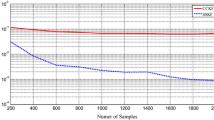Abstract
Long-range prediction of fading wireless channel quality is considered to be one of the most important techniques for high speed wireless communication systems. For example, to enable an efficient adaptive transmission, channel state has to be predicted several symbols ahead to compensate for delay in the feedback loop and adaptation rate limitations. Autoregressive model based linear predictor is addressed in this paper, in particular an impact of predictor order on prediction accuracy for various fading scenarios is investigated. The results show that memory length is an important factor that affects channel state prediction accuracy especially for fast fading channels.
Similar content being viewed by others
References
Catreux, S., Erceg, V., Gesbert, D., & Heath, R. W. Jr. (2002). Adaptive modulation and MIMO coding for broadband wireless data networks. IEEE Communications Magazine, 40(6), 108–115.
Alouini, M. S., & Goldsmith, A. J. (1999). Capacity of Rayleigh fading channels under different adaptive transmission and diversity-combining techniques. IEEE Transactions on Vehicular Technology, 48(4), 1165–1181.
Sternad, M., Svensson, T., Ottosson, T., Ahlen, A., Svensson, A., & Brunstrom, A. (2007). Towards systems beyond 3G based on adaptive OFDMA transmission. Proceedings of the IEEE, 95(12), 2432–2455.
Duel-Hallen, A. (2007). Fading channel prediction for mobile radio adaptive transmission systems. Proceedings of the IEEE, 95(12), 2299–2313.
Chen, M., Ekman, T., & Viberg, M. (2007). New approaches for channel prediction based on sinusoidal modeling. EURASIP Journal on Advances in Signal Process.
Svensson, A. (2007). An introduction to adaptive QAM modulation schemes for known and predicted channels. Proceedings of the IEEE, 95(12), 2322–2336.
Duel-Hallen, A., Hu, S., & Hallen, H. (2000). Long-range prediction of fading signals: Enabling adaptive transmission for mobile radio channels. IEEE Signal Processing Magazine, 17(3), 62–75.
Eyceoz, T., Hu, S., & Duel-Hallen, A. (1999). Performance analysis of long range prediction for fast fading channels. In Proc. of 33rd annual conf. on inform. sciences and systems CISS’99 (pp. 656–661).
Jakes, W. C. (1974). Microwave mobile communications. New York: Wiley.
Hwang, J. K., & Winters, J. H. (1998). Sinusoidal modeling and prediction of fast fading processes. In Proc. GLOBECOM’98 (pp. 892–897).
Heidari, A., Khandani, A. K., & McAvoy, D. (2010). Adaptive modelling and long-range prediction of mobile fading channels. IET Communications, 4(1), 39–50.
Semmelrodt, S., & Kattenbach, R. (2003). Investigation of different fading forecast schemes for flat fading radio channels. In Proc. IEEE VTC Fall (pp. 149–153).
Ekman, T., & Kubin, G. (1999). Nonlinear prediction of mobile radio channels: measurements and MARS model designs. In Proc. ICASSP’99 (Vol. 5, pp. 2667–2670).
Shen, Z., Andrews, J. G., & Evans, B. L. (2003). Short range wireless channel prediction using local information. In IEEE Asolimar (p. 1147–1151).
Sun, J., Zhang, T., & Liu, F. (2004). Nonlinear prediction of fast fading channel parameter based on the chaotic attractor. In IEEE 6th CAS symp. on emerging technologies: mobile and wireless comm. (pp. 282–286).
Baddour, K. E., & Beaulieu, N. C. (2005). Autoregressive modeling for fading channel simulation. IEEE Transactions on Wireless Communications, 4, 1650–1662.
Orfanidis, S. J. (1988). Optimum signal processing: an introduction. New York: McGraw-Hill.
Lindbom, L., Ahlen, A., Sternad, M., & Falkenstrom, M. (2002). Tracking of time varying mobile radio channels. II: a case study. IEEE Transactions on Communications, 50, 156–167.
Eyceoz, T., Duel-Hallen, A., & Hallen, H. (1998). Using the physics of the fast fading to improve performance for mobile radio channels. In Proc. IEEE int. symp. on information theory (pp. 159).
http://wwwcs.upb.de/cs/chsim. Accessed 12 November 2010.
Valentin, S. (2006). ChSim—a wireless channel simulator for OMNeT++. TKN Simulation Workshop, Tech. Univ. Berlin, Germany. http://www.cs.uni-paderborn.de/fileadmin/Informatik/AG-Karl/projects/chsim/ChSim-introduction-tkn-09-2006.pdf. Accessed 12 November 2010.
Author information
Authors and Affiliations
Corresponding author
Rights and permissions
About this article
Cite this article
Jarinová, D. On autoregressive model order for long-range prediction of fast fading wireless channel. Telecommun Syst 52, 1533–1539 (2013). https://doi.org/10.1007/s11235-011-9520-6
Published:
Issue Date:
DOI: https://doi.org/10.1007/s11235-011-9520-6




